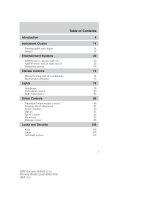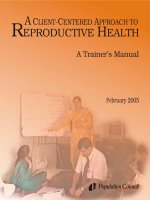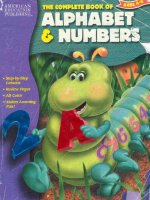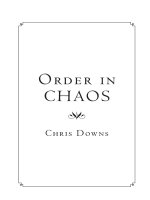book of exercises to accompany e. friedrich richter's manual of simple and double counterpoint (1888)
Bạn đang xem bản rút gọn của tài liệu. Xem và tải ngay bản đầy đủ của tài liệu tại đây (2.26 MB, 73 trang )
BOOK OF EXERCISES
TO ACCOMPANY
E.
FRIEDRICH RICHTER'S
MANUAL OF SIMPLE AND DOUBLE COUNTERPOINT
PREPARED
Bt
ALFRED RICHTER,
TEACHER AT THE CONSEBVATOEY OF MUSIC AT
NEW YORK,
LEIIPZIG,
G.
LEIPSIC.
SCHIRMER.
BREITKOPF & HARTEL.)
1888.
COPYBIGHT
1888
BT
E
6.
SCHIMMER.
PREFACE.
Shortly after the appearance of the "Book of Exercises
accompany Eenst Fried. Richtek?s Manual of Harmony",
I was repeatedly asked whether a similar work was not contemplated for the "Manual of simple and double counterpoint"
^Nevertheless, it was long before I could decide to set
also.
about such a book of exercises. For, instruction in Counterpoint is essentially different from that in Harmony. Here an
intelligent pupil can by means of diligent study and conscientious working out of the given exercises make, even without
the teacher's help, rapid progress. Not so in counterpoint. For
to
here the task is this, not only to construct the exercises corbut also to make them melodious and sonorous, which
cannot be done without continuous exercises, to be submitted
to the criticism of the experienced teacher.
Self- instruction
would here fail of its end, even in the case of the most talThen too, in the study of Harmony much depends on
ented.
working out very many exercises. But for Counterpoint comparatively few exercises suffice, inasmuch as a single exercise
can be worked out in the most varied manner; it can be utilized
as cantus jirmus for the soprano, alto, tenor and bass, and the
motion in halves and quarter-notes can also be applied in the
different voices; hence a single exercise can in this way afford
occupation for a week. I therefore considered a book of exBut when at last
ercises for counterpoint also unnecessary.
the inquiries became numerous, I attained to the conviction
But having
that here some necessity must, after all, exist.
once determined to set about the work, I went somewhat farther, and wrote supplements to the separate chapters of the
"Manual", so far as seemed necessary for better understanding
rectly,
them, moreover I developed more fully certain subjects only
and these supplements and extensions
have been added to the book of exercises under the title:
briefly indicated in them,
PREFACE.
IV
"Supplement to Eenst Friedk. Richtee's Manual of simple
and double Counterpoint".
"Why so many words about things at bottom so natural?"
perhaps many a one will ask on looking through this Supplement. But every one who has had, as I have, ten years' practice in teaching Counterpoint, knows that these things which to
one of us seem so natural and self-evident, to many others
do not at all
by no means in all cases devoid of talent
seem so natural and self-evident. By means of the repeated
questions put to him the teacher soon learns to know which
subject offers most pupils special difficulties and requires a
more diffuse explanation, and which is that subject that, as
being easily understood by the average pupil, can be passed
—
—
over more rapidly. The greatest mistake that a teacher can
by any possibility make is that of taking for granted that what
is perfectly clear and self-evident to him must be so to every
one else also. From this it may come that now and then
little talent achieve better results than those
of great gifts and eminent knowledge. For the former, having
had to apply great industry and pains themselves in learning,
are thu^ more easily enabled to conform themselves to the
mental process of others, than are those to whom everything
teachers of but
has come in play, and who are therefore inclined to look upon
every one else to whom that is not so easy, as a blockhead.
A somewhat slower intelligence does not always evidence lack
of talent,
for,
in learning, the
temperament also plays
its part.
Many
a talent lies hidden as it were in a deep pit, and can be
brought to the surface only slowly and through conscientious
The previous education also, especially the scientific,
differs too much not to have an influence
upon their intelligence and progress. Every one knows how
labor.
of music-students,
many, on hearing for the first time the terms
etc., to form a notion of them,
whereas, to one who has studied Latin, a definite idea is immediately connected with those expressions. The teacher cannot despair of the talent of his pupil until he sees that the
exercises, in spite of diligence applied to them, do not improve,
and that there is absolutely no development of the feeling fqr
the harmonically and melodically correct. To develop this feeldifficult it is to
"second", "seventh", "dominant",
may be, is precisely the affair of the teacher.
a mistake to suppose that this feeling is bom in us.
The feeling for the melodic, possibly: the talent of catching
up a melody is a very common one. But the feeling for the
ing, as far as
For,
it is
PREFACE.
harmonically correct
is
V
decidedly not inborn,
but can only be
The fact that there are many, who, without ever
haying had theoretical -instruction, can extemporize excellently
upon the pianoforte, proves nothing. For these are always such
acquired.
have played that instrument a great deal, in whom thereconformably to the nature
of the instrument they have cultivated, has developed itself
But to violinists and violoncellists it vnll always be very difficult (unless they are at the same time pianists) to write a
as
fore the feeling for the harmonic,
four-part setting.
Especially the bass-leading causes
the former great difficulty. The fact is that with them the
sense of harmony is, by reason of the nature of their instrument, little or not at all developed. Hence, too, in their case,
with the same talent and industry, progress will generally be
slower than with those who play the pianoforte or the organ.
Moreover, it may be observed in ordinary life how much more
general among the public is the feeling for the melodically
than for the harmonically correct,
for instance, in people
who play for dancing, or in those who, having a good memory,
can repeat every melody that they have once or twice heard.
They will reproduce every tone of the melody exactly and correctly, perhaps the harmony also, in so far as quite simple
chord-connections are concerned,
for instance, that of the
dominant vsdth the tonic; but if the course of the melody involves more difficult harmonization they directly play falsely,
yet without being at all sensible of it.
Such people make a
droU use also of the chord of four-six, bringing it in without
correct
—
—
fail
it
when
it is
not expected, and, when
it is
expected, leaving
out.
That which I have given as complementary to Chapter 6
(Choral treatments) has taken on especial copiousness. In view
of the limited presentation that this subject had, and had to
deemed it necessary to treat some points
more diffusely. The treatment of Chorals in the ancient Churchmodes has also found a tolerably detailed discussion. For athave, in the Manual, I
a thorough
taining
modes
it
understanding
was of course necessary
of these
ancient
Church-
to bring within the
sphere
of our observations the tetrachord-system of the Greeks, as the
For, surely,
starting-point of our modern tonal system also.
the musician should know something concerning the rise, the
nature, and, above all things,
the
treatment of these Church-
modes.
The question
is
very often asked by students,
how much
PREFACE.
VI
time should be devoted to the study of Counterpoint. This is
a difficult question to answer, in so far as progress depends
upon the scholar's industry and talent. What is for the one
In general it
too much, might for the other be too little.
might be recommended, even for the talented and diKgent, to
devote a whole year to the study of simple Counterpoint. Many
have no real patience for conscientious study: they -would like
to learn every thing the soonest possible,
make
superficial at-
tempts at every species of counterpoint, and think they have
done great things when they have in a short time finished the
for it deserves
entire theoretical course. Such hurry-skurry
no other name
leads to nothing, and they who do such
things simply do not know why they study counterpoint. Counterpoint is for the composer what technique is for the pianist
or the violinist, and, as it is necessary first to have acquired
the requisite execution in order to do justice to the works of
the masters, so also should one he a thorough master of coun-
—
—
make
proper use of one's ideas. I thereon to the study of double
counterpoint too quickly. For, double counterpoint is, in the
main, nothing else but a simple counterpoint with certain limitations, and he who is capable of treating simple counterpoiat
in a flowing and melodious style, vdll require comparatively
little time for the study of double counterpoint and soon be
able to pass on to higher problems.
In conclusion I would add, in reference to the "Book
of Exercises" proper, that in selecting the Chorals I allowed
myself to be influenced by practical considerations only. The
statements as to the origin and the composers of these melodies lay no claim whatever to absolute correctness. The statements of investigators in this department differ considerably,
and the investigations themselves are as yet by no means
ended.
The folk-songs that have been utilized for exercises
are mostly taken from the "Old-German Song-book" by Feanz
M. BOHME.
terpoint in order to
the
fore give the advice, not to pass
—
Leipsic, Jan. 24, 1884.
Alfred Richter.
To Chapter
II.
Plain Counterpoint.
Exercises without the application of Modulation.
(Supplement to No. 25 of the Manual.)
1.
TO CHAPTER
14.
^
II.
.16.
ja.
-^~y-rr
^E^Sg-iE^j
16.
sc
f±Eif^=^a^i|;
gi
The Cantus firmus is here given to the soprano, but is to
be taken by the other- Toices also, as follows: for the alto it
is to be transposed a fourth or a fifth lower
thus, from C-major
to G- or i^-major, for the tenor an octave lower, for the bass
two octaves lower (the same key being therefore retained in
the last two cases). It is moreover advisable to take the exer-
—
cises at first in the
and
,
simpler keys,
afterwards,
when
as,
C,
greater
G
and jP-majqr,
dexterity
has
a,
e
been
on to the more difficult keys. This applies to
the succeeding exercises.
attained, passing
all
In the "Manual of Simple and Dotible Counterpoint" it is
(p. 16, No. 4) that ^^Modulations are to be avoided, except
in rare cases, where, for special reasons, those leading into the
nearest related keys may be used." In the fir,st exercises this
rule should be strictly observed, but after the requisite cersaid
tainty and practice in
construction have been attained,
lation may, of course under
certain conditions, be
modu-
applied in
moderation. It will, in fact, be necessary in all cases^ where
the course of the cantus firmus prescribes it, as for example:
c.
.
f.
^z^-z^:-^-^
&,.
h.
r^c:Tzi^n-^^r
^-za
PLAIN COUNTERPOINT.
as ^-minor
h
is not related to C-major. But modulations
nonrelated jkeys are to he strictly excluded. (Concemiiig relationship
of keys see Supplement to the Manual, p. 10.)
.
Exercises with applied modulation.
(Supplement to No. 25 of the Manual.)
1.
¥^
s*
W
/-,
I
^
^
^4.
^
^
^
"
I
^
3.
S
25ZIJS:
5=^5?:
s
5.
1^
a.
TO CHAPTER
4
III.
FIGURATED COUNTERPOINT.
15.
^^
16.
—-[-j^^^—g-p^g=[-^'^-^-^^^-
-O-.
fi-jj»—
w~
The cantus firmus should be applied
also,
in the other voices
proceeding, in the transposition of this as of all the fol-
lowing exercises, in the way already indicated.
To Chapter
III.
Figurated Counterpoint.
For working out with the movement in half-notes in the
exercises under No. 25 in the Manual, as
different voices, the
also the following ones,
may
serve.
—^-iL^-^^^_-^^-^^_
TO CHAPTER
IV.
COUNTERPOINT IN QUARTERS,
etc.
5
To Chapter IV.
Oounterpoint in quarters against
The working out can be done
ercises, as also
"with all the
preceding ex-
2.
i^z:r^
^g--
3t
'f^-^z^]^
fF
^
^
:^
3.
jSL.
^
notes.
with the following ones:
1.
*'
wMe
fe
=^
:i^
at
3jr
TO CHAPTER
VII.
Exercises.
(Supplement to No. 70 of the Manual.)
1.
^
s; ^E
32.
'^SZ-^
ISlXSHZ
3.
M.
fcit=s:
s^F^^l^^F^
%
ZBL
f-
^^
*
1.
.^>
:g=t^
A^=^qfe
B/5
ô'
f^
6.
5.
ffg
fc
Sft
^
M
srxSujpz.
m.
M
^e
'ã
^
ãtfL^*
.ffl
fc
8.
fi^
a
-S-
Iff-
-as::
To Chapter VI.
Two-voiced Oounterpoint.
Here no special exercises are given, as the preceding ones,
which may again be utilized here also, will in every respect
suffice.
To Chapter VII.
Treatment of the Choral in plain counterpoint.
A. Chorals in modern keys
Kemark. In
[i.
e.,
in major and minor).
transposing the cantus firmus into the alto , tenor and
It is assilmed, however, that, before getting
about treatments of the choral with the eantus firmui in these voices, sufficient dexterity and certainty in voice-leading have already been developed.
bass, proceed as befort.
—
CHORAL IN PLAIN COUNTERPOINT.
For, these exercises oflFer difficulties in various directions. The peculiar
course of many of the melodies will easily mislead to forced progressions
Then, too, we have to pay attention to the leading not only of the bass,
but of ihe soprano also. For the soprano should not, any more than the
remain stationary or contain unmelodic and meaningless progressions.
it is necessary that the cantus Jirmus appear as prominent as possible,
while on the other hand care must be taken that the soprano also be melodiously sustained. A treatment in which this latter is lacking, would, in
spite of the greatest harmonic richness, sound colorless. We should beware,
moreover, of ascribing to these exercises, so far as they concern alto and
bass,
Here
The essence of a pielody, so far, that is, as
of a purely harmonic treatment, is, in the middle voices
tenor, too great importance.
there is question
after
aU
most cases
in
It is otherwise
stifled.
with the application of the
freer contrapuntal forms, in
which through the difference of movement of
the separate voices one with another, as also through the contrast of the
figures conditions are created by which an application of the cantus Jirmus
in this way is even favored.
Among the following chorals are some that
were originally composed in ancient church-modes, but in which the melody has in the course of time so changed that the original church-mode
can no longer be authenticated or at least recognised.
—
Abide In thy great mercy
Ach
bleib
—
mit deiner Gnade
No.
tS
1.
is
my
life-spring
mein Leben
VxJLPnJS, Cantor at
Weimar
fW^Ws
:^
W=^
*:
—
—
ieOl.
2=
-zc
God and Lord
—
—
Ach Qott und Herr
From the 2d half of the
^^^
X
No. 2.
that
(Christua, der ist
Melchiok
=^
He
(Christ,
—
L&#
^=1=
is—f!r-
-^-
^
16t5»
or the 1=' half of the ITth century
-.^
^
f3tL.^
God, how many a bleeding
lieart
t
—
^&-
jA+^
(Lord Jesus Christ, light of
—
Ach Gott, wie manches Herzeleid — (Herr Jesu Christ, mein's Lebens
Licht —
NIC. Selneccer, Superint. inl,eipzig. 1530—1592.
my
life
)
^'No. 3.
r
:^
m
:zi=i^-\
,
^^^
ffl
t=t
p-^0T*
—.*
=t
.^:LaUV>zgq:?g:
t=t
t=x.
t=^:t
-fi>-^
TO CHAPTER
VII.
To God alone on high be praise Allein Gott in der
m^
No. 4.
Hoh
NIC. Decius, 1539.
sei JEhr'
^-rg-j-p'-Tsqr^
^^
gzHES
l^
n^T"^
«
-«
^4-
—
!S>- -e>-
-<s>
£
i=t:
=p=i»-
f»
t=t
£
?g~n^
:t=t
!^
I
r =1^=^
r
text is by Decius, to whom also the melody is ascribed,
more ancient testimony is lacking (see Gael von Winter-
Bemark. The
though to
this
feld's "Evangelischer Kirchengesang", Part
On
river-banl(S of Babylon
An
Bdbyhn
Wasserjliissen
&~r-^—
—
—
Martin Luther.
g ^
=-l
p. 210;.
I,
>vr
.
I
;^-i-^P
1
1-525.
1
No.
P^^g
E^
±
-iS-—'*-
2— (=n
^
by Luther.
SH^5
t=tl 3^
g
i
-j:t=2^
Bemark. The melody
as above
FT^=^q^#
-^
4=t
l¥»=t
—
(^
It
SE
^
—.g--^
I
originally that of a Hussite song, arranged
on account of the beginning, not suitable for
is
Is,
the cantus firmus in the bass.
From the grave again
shali thou arise
Auferstehn, ja auferstehn
No. 6.
^^?
^
t=^
icirat
du
—
—
Ph. E. Bach,
(t 1788.)
^^^aE& ^—^ ^
l=tt=t
^^-Jf^-]^^^^Egg=rf^^^Pt^
Beraark. Not to be used
as cantus
firmus in the bass.
CHORAL IN PLAIN COUNTERPOINT.
Christ, thou
1^0.
7.
who
Christ, der
du histder
^
S
art the shining
day
Tag
helle
—
^=*
—
Mich. Weiss. 1530.
tzt-t-t-rx
'fs—?r
S*^S
—
The Lord extol ye heathen all
loht ihr Heiden all
Den Herren
No. 8.
^
^^^^3
^
^g^yi-^
1^
—
^
1=t
^T=??=
^r-Ytf
fW=ff=^
=F=T^
?
Thy name, thy name I sing Jehovah
Hir, dir, Jehova will ich singen
No. 9.
Ơ^
5^
iLjSi.
Ê^tP^=^
t
ôH-(=-
Geoeg
3=+
g_ gL
:
s
Joseph:. 1730.
^
TO CHAPTER
10
VII.
—
Arouse thee,
No.
my
Ermuntre
mein schwacher Geist
dich,
feeble soul
^
^gi
w-
II.
•|a
|g
JOH. SCHOP. 1640.
ii»^-^B-
i ^^&t S
I
3zzz:
W--
^^
S
^-^—^=^^
^
t=
It
Is
Es
—
-fii—fH-
t=t:
:^=^
a—
^^^
t=^
"^f=^-^
tE& —
gg
(g
A;o«tei viel, ein
:5=?s:
X-±^
^
^:v
^
4='
—
(2=
w te
^^^
(^
|g
p g
t=t
j
I
P^
/>>
big
'
^gFfF^^^^ ^^
—
^ffJ
c^.
^
God of heav'n and of the earth
Gott des Himmeh und der Erden
a
I
^^^^^^
^^^^^^^
£
No. 14.
(+ 1673.)
HS^_(ffi_P?J=«L
^&
No. 13.
—
passing hard, the Christian lot
Christ zu sein -
'Tis
£«
^-fi'
enough! Receive my spirit, Lord
genug! So nimm, Serr, meinen Oeist
JoH. KuD. Ahle.
P^
f^
-!&--«.
ist
rr^^g
No. 12.
^>g-
F=^EJ
^
—
Heinrich Albekti.
-TS-^-F-
«—(*-
"SZ-s^^-ZS.
:S
3
£«
=SC
1640.
SI
^^r^Ff^
CHORAL IN PLAIN COUNTERPOINT.
—
God
Is my song
Gott Ut mein Lied
No. 15
—
^F^
a.
*-T*
r
my song
Is
Qott
\si
-^
—
mein Lied
^^
i^
No. 15 b.
ajgg^qfjg
It.
^
God
I
r> g rTr*^
I
f'
—
S^ E
^
Ph. E. Bach.
-f—i^
g?
t=l
-^-7^
"m
!»-
-»zst
Bemark. Not
I soroly have transgressed
Herr, ich hahe missgehandeU
—
&
113ft
"'
'^
i^
{+ 1788.)
S
Sr
applicable as canttis /iiinus for the bass.
Lord,
NO. 16.
H
3
t"
9
I
»p
^
-
l^ -jg-
3
/g
(g'
It
^«=?i^
1=±
3CZ=5=
Remark. Composer of the melody unknown. It is ascribed by many to
Joachim von Bvbok (died 1580), but, according to Wintbrfeld, without
reason. ySee C. YON Winterfkld's "Evangelischer Kirchengesang", Part I,
p. 403.)
—
Lord Jesus Christ, to us Incline
Christ, dich zu uns wend
Herr Jesu
No.
17.
^t^Pfe^
Wi=^
to
—
^ny7n"i^ta^^
^
ryi";^7>T
5=t=
i^ f
Bemark. Melody probably
John Hubs (died 1415).
«
g
ffeg
that of a
^E
e
>
t=t
Bohemian song.
Is also ascribed
TO CHAPTER
12
Lord Jesus Christ, Thou greatest good
HeiT Jesus Christ, du hSchstes Gut
Probably from the
VII.
—
—
—
-^-
No. 18.
-e>
half of the ITtl century.
^3SZ
ri-
a
s
(
Is'
f=f=f=f=^
SI
>
—
|g-
|
^
g—H^
rj
4=Q
-#—15- :?2=«= 'TS'^cr
Lord, as Thou wilt, direct
Herr, wie du
my way
willst, so schick^s
•
i
m^
^ffi^^
^sz
19,
"•
—
=F
^
^E^z^
:5=F
^
17*
century.
?2==^
:t=t
-ei—^-
^=t
t=t:
2C
the 1^* half of the
t=t
sti^cs^i
ggjE
a
—
mit jnir
From
No.
^
^=^
.
±=t
^:i^
t=t:
love Thee, Lord
With all my heart
Herzlich lieh haV ich dich, o Herr
I
Mich. Gasteeitz. 1580.
^(t;XlJf-pjg^nl7^ffmf
NO- 20-
s=f-&5=^
E^
—
-»
|i?-=F
.
^
i
rg
n
a
g>
<:'^-:i^--»-l?^^^g
|3^=t=F
S
sz
:t=t
g~| fg_gjpg:
^
hS^
^^=^
e:
r??=^
£
(C
au
-^
mk
t:=^
t=t
CHORAL IN PLAIN COUNTERPOINT.
Beloved Jesus, what hast Thou
Herzliehster Jesu, was Jiost du
'"•
—
—
JOH. Ceuger, 1640.
P^^^S
t=t
"
13
g-JIfg"
S
f
-^E^
.
^
-^^
w=?-rr-^r^^f=^
^t
Hfi-
"^
I
my Father
Herre
thank Thee,
Ich dank
:t:t
-gr-jg'-
dir, lieber
—
—
m
=?=:
1^5^
grr'nT'rgfiT^g
No. 22.
i£
^
^=^
(
ij^id
rp^
fefc^^S
Remark. Melody
Walde"
>-'
2S=±:
origiually that of a secular song ''Entlaubet ist der
and demonstrably comes doini from
("All leafless is tlie forest"],
the vear 1535.
—
— MiCH.
thank Thee surely through Thy Son
Ich datxk dir sdion durdi deinen Sohii
I
m
^^^^
g 9
No. 23.
'ã"ã
ô
IF^
In
y
^
iC"
r*
^ g
I
PrJETORIUS. 1610.
fi
-
j
t=t=1=
jg.:^zr^|^ .g'ljg .aTTf^ffll.^
32=1=
have reposed
God my trust
mein Sack' (rott heimgestellt
I
Iclt hab^
Melchior ViLrirs
No. 24.
1^3=^^
S
BE
f^
t=^ tfv
f
E
I
r
f-^
E£
^=z^^q^^4^
i^H^'^-f-ffiM
^A »
^
;+ 1616).
I
f^
P
I
g
TO CHAPTER
14
VII.
—
know, my God, that all my deeds
I
Ich weiss mein Oott, dass all mein Thun
Michael Pk^tokius.
^S^^S^^S^S
(?)
r!-f- -7s:s=\
t^=:«
No. 25.
=t^=4
£
=F=F
fJ^=F
3^
—
— Melchiok Frank
Jerusalem, thou city high-upreared
Jerusalem, du hochgebaute Stadt
^^
No. 26.
e^
-s>—(S-
5=^^
Jesus, thou
Jesus, der
—
1638.)
^
?2=3
g
S ^^^
:t=^
is:
(1609
^s^
Tig-
I^Z
\
who hast my soul
du meine Seele
—
—
(Alle
Menschen mussen sterben
—
JOH. SCHOP. 1640.
W- 5
No. 27.
gi-hg-
^
^1^^
^
J g g+p
1
22=^
i
g^
1^
^^*=t=:5
I
S
:t=i:
£^:
ai-
&!
:?2=
A
Remark. Not
of the 2* stanza
which
is
be used as cantus firmus for the bass, as the end
on a half-close, hence on a chord of four-six,
fall
utterly prohibited.
Come Holy
Komm,
No. 28.
to
would
Spirit,
heiliger
^
^
¥i^^
—
—
sovereign Lord
Herre Gott
Geist,
=t=
-^-iS-
-(=<-
Martin Luther.
-i=^
fe
t=^ 1=t
^^^m
^^^H-
g
g
(
I
eJ -isr
iv
m
CHORAL IN PLAIN COUNTERPOINT.
£
g
*=tt
P -l--^
t=^ s—'^ t=t:
-V-\-^-
Eemark. The melody
extend' back to the
frequently disputed.
3
.==--«^
above form comes from Luther himself,
an old Latin church-melody alleged to
century, though this has in modern times been
5t)>
—
fee
32;
^^
in the
said to have utilised for
is
E
(
rr^t-r:t=p3
who
l*V.fi^
15
Not
it
suited for cmitus Jirmus' in the bass.
Come, sons of men, extol and praise — {AH people that on earth
;
do dwell).
Hommt Memchenkinder riihmt und preist -rClaube Goudimel (born 1572).
t=t
^ T^'p-^
No. 29.
^—\-
:?!!--i»
-#— fg
a
i—
t^t=^^
1
f
-(42-
:t:-
JoH. RuD.
^
^
fg
I
.-.,
-^—»-
g-^
-A-II
|g
I
Able
(t 1673).
f f
1—4—
I
1
1
i
^
t=t
h-
1
-I
Dearest Jesus, we are here Liebster Jesus, wir sitid Jiiei-
3
^s-, e?
-
1
No. 30.
£
^?^ e>-rP—fi^
^2=
a ^^am:^^^
i
Praise ye the Lord, the almighty King of glory
—
Lobei den Herren, den mSehtigen KSnig der Ehren
—
Joachim Neandek.
jX^f^uX^^ fe a
No. 31.
-
fg
w
j
g g ^' T~^ a 9
'
|
I
\
I
1660.
s
< >
t>"
-TTiJterTt^
rO CHAPTER
16
VII.
Praise God, ye Christians, wiili one voice
Oott, ihr Christen, alhugleich
LoM
No. 32.
^^
F#=^
9-T-&&r&-
si
Hekrmann.
1561.
i^
NiC.
lô-(a-
(ô.ã-
t4
-^ằ
t=t==t=4
-?^^
ã|fiô-
1
I
Bemark. Melody probably borrowed from
I
from Jesus ne'er
Meinen Jesum
will stray
lass ich nicht
a folk-song.
—
—
Andr. Hammerschmidt. (born
No. 33.
1611.)
w^^^^^^^^^^^^^
^^=i^^pfe^^%j]f=£r£
Bemark. Not
Nach
—
many days
Prufung kurzer Tage
einer
af^-[^
suitable as cantus firmus in the bass.
After a trial of not
—
JOH. GOITFR. SCHICHT. (17531823.)
=^^
^-r,
\^,
No. 34.
^-
^--s>-
i=t
s
-1=
Now
Nun
r-l=^ !ằ-
-1=
we
danket
all
alle
-s
^(^
e^
^s
Ơ^
{>ô-
thanl<
-(K iff--
t=t=
-iS
NO. 35.
J
j=
a=v.
our God
Gott
JoH. Cruger. 1649.
si-^ia.-
t=t
-<ằ-
t=t
j
=?^=^
=t=|:
^
1=1:
%
-t9
|-f2
-(e~ô-.
^F=ff=^?^F
r^-:z^
p^S'
f2
^_
CHORAL IN PLAIN COUNTERPOINT.
Rejoice ye now, dear Christian band freut euch liebe Christen g'mein
Nun
"-"^
^
1524.
^^
-S'—fS'-r-f'-
*E
t=:t=:4
^^^^
—
tT^-l
:t
Now
praise
Nun
lasst
^
No. 37.
rij
we God
um
tlie
C »
>=5
>5
liusKed are
JVmjj ru7ien alle
^
^
w^
^
—
all
i^-
^
t=t
i^J
—
'
^i-g:
Heinrich Isaac. 1475.
g
(g-
(=-^s^
1=t:
I
i^:^
-!S^I=-
^^
."
Bemark.
1592.)
the forests
WUlder
r
—
-•—(=^^=^
i=i=t==r=t
?"i
I
NiC. Selneccer. (1530
i
3E-I
g
Now
—
Lord
GoU, den Herren
=B
^
Dr. M.Luther.
SfipT^7=aE^
j^
E
No. 38.
17
^=t
^— P -
>- -)g-
Melody
g
S—^^Sh
(^^-«-
originally that of a folk-song: ''Inspruck, ich
muss
dich lassen."
Now
that the day has reached an end
Nun
sick der
Tag
geendet hat
-V
^
l^=^=P^
^
—
-g^g-4-p^ ^-^—^^^^
:^=t
kNo. 39.
—
t=t
sz
:t-:
-^—&-
5=t
¥=^
A. Richtbk, ExerciseB of the Uasual of Coimtorpoint.
^
^"
g'T'f"
r
jsr-jg-
=> -
<
TO CBAPTES,
18
O
No.
«a.
God, Thou righteous God
Gott, du frommer Gott
JoH. See. Bach. 1730.
^5jE^^^^gi_q^^a
-
^
&
i
P4f.^fp=3=^
y
^
fe
1^
God, Thou righteous God
O
No.
VII.
40 b.
du frommer Gott
Gott,
^
iff
:t
jv
S
-ã#-
JoH. Fkiede. Doles. 1760.
^^$^Ê3
-ggi-
^g-l;gi-
^
^a-ô-
t=j
^^sgpgli^fzp]:^:^|p^
#
^^g ^te ^ t=^ S
fe^g
Lamb
of
O Lamm
N0.41.
God unspotted
Gottes unschuldig
:t=t
=5=^=^,:::^
^
S
-!ằ
g
^ t=t
g
^"Hr-'g^ Ê
^^Ef
1=-
,
r^ -
^
ã3*~i~gg
#!ô- r
p
^
=t=i=
Bemark. Composer not known. Song and melody were
ascribed to NiCH. Decitjs
sorrowfui,
O
No. 42.
(+
heavy heart
Traurigkeit, o Serzeleid
^^
—
—
From
^^^=^^^
j=3:
=t
formerly
1524).
the year 1625.
^^e
CHORAL IN PLAIN COUNTERPOINT.
^h^-
3C
^??=»^
t=J:
1f3=
:s=
£
19
=1=
=F:
Remark.
This melody was not composed by John Schop, as was
formerly universally believed, but, as has been convincingly proved in
modem times, is borrowed from a Catholic hymn.
Thou treasure
of all treasures
Schatz Uber alle SchUtze
No. 43.
—
wpe
—
nrrvrf
-<s>—^
t^f^rvT^
t==x
^^
S
?s=rzsr5:
Deck
thyself,
soul beloved
Schmiicke dich, o liebe Seele
fe
No. 44.
o—sf1=:*:^
£
t=t
7^T
=5^^—«t
a=rfS=
3^s
—
—
JOH. CRiJGEE.
(t 1662.)
3?==^
:2fcz^
4=*
—g-
-g<
tf
4=t:
Should
SoW
No. 45.
I
3
—a
.fg— p.
g g
W^-<s—e>-
t=X:
-jS^f"I
I
:±i:
I
-r
j
g
f —p-
S
t=t=f
E^^ 3^^sfc z^=^
1=t:
«—(=-|
JoH. SCHOP. 1640.
S>-
?2^:?t=5
^
-
s—
*
^
1
.
-f=^!S>-
not God's praise be singing
ich meinetn Gott nicht singen
i^czipi
"^
—
-^
q=t
,
s
>
=fc
2*
a~"?g
TO CHAPTER
20
me
wrath chastise
In ihy
not
—
—
Straf mich nicht in deinem Zorn
az22:
JOH. ROSENMULLEK.
=M:
,7^~r rT- ""3=^ "^ "-^-^ ^-
•
=fe
ct
No. 46.
VII.
(! 1686.)
^ "^
I^^^T^=^p-Hr^te^EgE&
=t
Remark.
Melody
not suitable for cantus firmus in the bass.
—
—
Wake, awake, the voice is caliing
Wachet auf, ruft uns die Stimme
r=T- qg
f
S
!&t=E
E*S3
s
;
::fzi?j
(^
—I
-4
^i
a-
(^
S
^^
^^^^^^
f^^
When we are
Wenn wir
"»
SS
^
w^
^^^^
No. 47.
JAC. PrjetokITJS. (+ 1651.)
ôã:
in
our utmost need
Nsthen
in hSchsten
sein
JOH. BapT. BonomeTTI. 1560.
^f=^^g^::^^
=3p
i=-ô^
SI-
p^^^^^f^^^du^-CF^^f^
Who
travels in God's
Wer
No. 49.
Gottes
V
=t=4:
1f^
Wege
/V
E$ jg'l-.'g'—
t=^
—
J.
^^
Qttanz. (t 1775.)
^
t=t:
-4—1^
E
s-
<
way
geht
P-
eJ
^^
ES:
-S>-r^—^^rS^-S>-r-(=^
=t=t: =l==t±t
^
1









